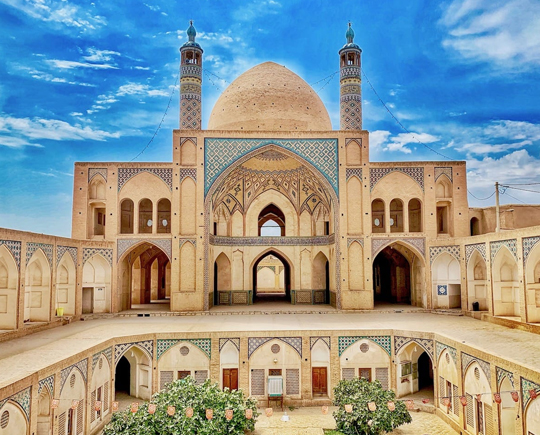Iran (IR)

- Valid for 30 days
- Extendable up to 60 days
- Requires a passport with 6 months validity
- Visa on arrival available for some nationalities
- No Israeli stamps in passport
1. Check Eligibility:
- Ensure your nationality is eligible for a tourist visa to Iran.
2. Gather Required Documents:
- Passport (valid for at least 6 months beyond your stay).
- Passport-sized photos (2 recent photos).
- Completed visa application form.
- Proof of travel insurance.
- Travel itinerary (flight and accommodation details).
3. Get an Authorization Code:
- Contact an authorized Iranian travel agency to get an authorization code. This code is necessary for your visa application.
- Provide the required documents to the agency for processing.
4. Fill Out Visa Application Form:
- Download and complete the visa application form from the Iranian consulate or embassy website.
5. Submit Application:
- Visit the nearest Iranian embassy or consulate.
- Submit the completed application form, passport, photos, and authorization code.
Sure, here is the information you requested in a simple and easy-to-read format:
If you are planning to visit Iran and need to apply for a tourist visa, you can use the following direct links to the online application portals:
2. Iranian Ministry of Foreign Affairs
These links will take you directly to the official websites where you can start your visa application. Before you begin, make sure to have all necessary documents ready.
Sure, here's a simple and clear list of documents needed for a visa application to Iran:
1. Passport: Valid for at least six months beyond your planned stay.
2. Visa Application Form: Completed and signed.
3. Passport Photos: Two recent passport-sized photos.
4. Proof of Accommodation: Hotel booking or a letter of invitation from a host in Iran.
5. Travel Itinerary: Detailed trip plan, including dates and places you will visit.
6. Travel Insurance: Proof of medical and travel insurance covering your stay in Iran.
7. Flight Tickets: Copies of your round-trip flight booking or reservation.
8. Visa Fee Payment: Receipt or proof of payment for the visa application fee.
9. Cover Letter: Brief letter explaining the purpose of your visit.
10. Supporting Documents: Additional documents depending on the purpose of your visit (e.g., business invitation letter, student enrollment)
Sure, here's a simple guide on how to extend your visa in Iran:
1. Check Eligibility: Before starting, make sure your visa type allows for an extension.
2. Visit the Immigration Office: Go to the nearest Police Department of Alien Affairs. Major cities like Tehran, Isfahan, and Shiraz have these offices.
3. Bring Necessary Documents:
- Passport with your current visa
- Passport-sized photos
- Completed application form (available at the office)
- Proof of accommodation (like hotel bookings or a rental agreement)
4. Pay the Fee: There is a fee for extending your visa. The amount varies, so check the latest rates at the office.
5. Submit Your Application: Hand in your documents and application form. The staff will guide you through any additional steps.
6. Wait for Approval: Processing times can vary. You might get your extension the same day or need to return in a
Traveling to Iran requires a few specific preparations:
1. Visa: Most travelers need a visa to enter Iran. You can apply for a tourist visa online or at an Iranian embassy.
2. Passport: Your passport must be valid for at least six months from the date of entry.
3. Travel Insurance: Proof of travel insurance is required. You can buy it in advance or at the airport upon arrival.
4. Health: No specific vaccinations are required, but it's wise to be up-to-date on routine vaccines like measles, mumps, rubella (MMR), and tetanus.
5. Currency: Bring enough cash (preferably euros or US dollars) as international credit cards are not accepted in Iran.
6. Dress Code: Women must wear a headscarf and modest clothing covering arms and legs. Men should avoid shorts and sleeveless shirts.
7. Customs: Alcohol and pork products are strictly prohibited
When traveling to Iran, it's important to respect local laws and customs to ensure a smooth and respectful visit. Here are some key points to keep in mind:
1. Dress Code: Women must wear a headscarf, long sleeves, and long pants or skirts in public. Men should avoid shorts and sleeveless shirts.
2. Alcohol: Alcohol is illegal in Iran. Do not attempt to bring it into the country or consume it.
3. Public Behavior: Public displays of affection between men and women are frowned upon. Holding hands is generally acceptable, but kissing and hugging are not.
4. Photography: Avoid taking photos of government buildings, military sites, and airports. Always ask for permission before photographing people.
5. Religion: Iran is an Islamic country, and respect for religious practices is important. During the holy month of Ramadan, avoid eating, drinking, or smoking in public during daylight hours.
Sure! Here are some quick and interesting facts about Iran:
1. Rich History: Iran, historically known as Persia, has one of the world's oldest continuous major civilizations, dating back to 4000 BC.
2. Capital: The capital city is Tehran, a bustling metropolis with over 8 million residents.
3. Language: The official language is Persian, also known as Farsi.
4. World Heritage Sites: Iran boasts 24 UNESCO World Heritage Sites, including the ancient ruins of Persepolis.
5. Cuisine: Iranian cuisine features delicious dishes like kebabs, rice, and stews, often flavored with saffron, turmeric, and herbs.
6. Nature: The country has diverse landscapes, from deserts and mountains to lush forests and coastlines along the Caspian Sea and the Persian Gulf.